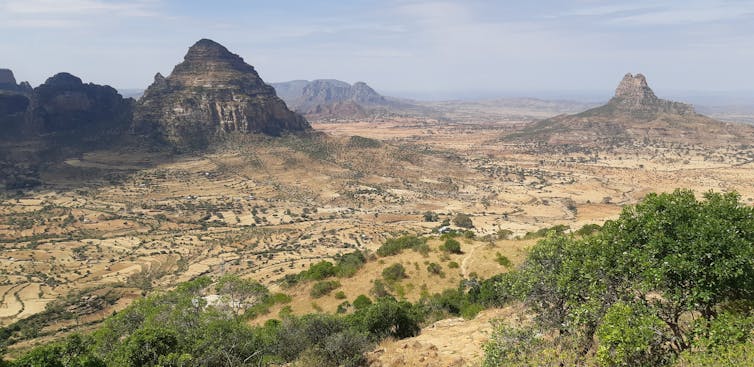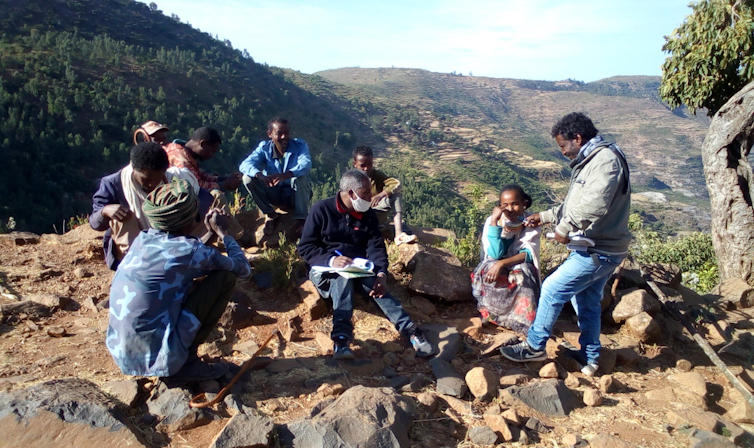
Jan Nyssen, Ghent University; Biadgilgn Demissie, Université Libre de Bruxelles (ULB); Emnet Negash, Ghent University; Hailemariam Meaza, Mekelle University; Sofie Annys, Ghent University; Tesfaalem Gebreyohannes, Mekelle University, and Zbelo Tesfamariam, Mekelle University
The war waged by the Ethiopian Federal Government and Eritrea against the Tigray regional government, which lasted from November 2020 to November 2022, caused massive devastation. Multiple war crimes were reported and there were claims of genocidal intent. A starvation campaign led to the death of at least 300,000 civilian victims.
One of the places that managed to escape the destruction was the Dabba Selama village. Located in Tigray’s Dogu'a Tembien district, the village is composed of four settlements, home to about 5,000 people. These settlements are scattered around one of Ethiopia’s oldest monasteries. Located on an isolated, elevated, flat ridge, the community is highly dependent on agriculture.
We’ve published a book on the Dogu'a Tembien district, based on 25 years of geographical research in the district. In January 2023, after the war had ended, we returned to the district to continue research on the society and environment. We focused on 10 villages in Dogu'a Tembien, one of which is Dabba Selama.
The residents of Dabba Selama consider themselves lucky. Other villages became targets for military attacks. In four of the 10 villages, massacres of civilians occurred. Women and girls were victims of sexual violence perpetrated by military forces. Homes, schools and farm products were deliberately destroyed.
Even though the war front moved past Dabba Selama several times, the community suffered less than the other villages we studied, thanks to their geographical isolation, strong community bonds and agriculturally productive landscape.
Isolated
During our interviews we understood that there was no warfare in the village itself and no direct civilian casualties. Unlike the nine other villages we visited, the interviewees in Dabba Selama did not mention children or elders dying from hunger.
Because the village and monastery are in rugged terrain, some 20km from the nearest road, Ethiopian and Eritrean armies marched through the settlements just once and did not stop in it. The community’s grain stores and other assets weren’t looted, burned, or purposefully ruined by soaking or admixing of soil, as in other communities. The farmers had food even during the critical period. Many of them could afford to buy some (expensive) additional food or medications.
It is also fortunate that the one time the soldiers crossed the village, they didn’t notice the monastery beyond an overhanging cliff and nobody informed them of its existence. Otherwise, they might have invaded it. The armies believed that
.Strong social bonds
Those interviewed said that, despite the suffering, people helped each other. This contrasts with other villages we visited where the big complaint was that social bonds had become much weaker.

In Dabba Selama, community bonds were strong even before the war, like most remote villages. People typically helped each other with cereals or money, and this continued. The community – including village leaders – shared what they had, so people survived. In other villages, leaders sometimes diverted aid or supplies to their family members.
Food stocks
When the war broke out, the village had some food in stock. The farmlands in Dabba Selama, especially those on the high plain, are relatively productive and farmers had cereals in their granaries.
Not far from the village, at the foot of steep slopes, there are springs. The farmers use these for small-scale irrigation. With its rugged terrain, good rainfall and warm temperatures, the area is also suitable for keeping livestock.
Many farmers from the village traded fruit, selling it at nearby markets when there was no active fighting.
Ability to hide
At the end of 2020, when the war front came close to Dabba Selama, the farm households abandoned their homesteads. They fled to the gorges and mountains with their livestock, flatbread and food supplies, including flour, spices, coffee and salt.
Before leaving, the farmers dug pits in the ground and hid the grain bags they had in their houses. Old men, who are traditionally perceived to be less exposed to brutalities by the military, took the responsibility to supervise the houses in the village. Fortunately the fighting did not come close. In nearby villages, this strategy went wrong and it’s reported that elders were massacred, but not so in Dabba Selama.
Tough times
This is not to say the residents of Dabba Selama did not endure hardship. The community struggled to produce food. Many farmlands in Dabba Selama were not cultivated on time in 2021 and 2022 due to the war. It was difficult to get seeds and fertiliser.
Farmers mainly sowed teff grass (Eragrostis tef) in the absence of other seeds. Compared to other crops, teff gives lower yields per farmland area.
The seed shortage was partly due to hunger. Many households had to eat the grain seeds they had conserved from previous harvests.
Crops were poorly managed because of the war, and the yield of 2022 was worse than any year at peace time, given the total absence of agricultural inputs.
In addition, reforestation areas and natural forests were affected by wood harvesting and charcoal preparation made necessary by poverty. Over the 30 years before the war, a strong effort had been made to regreen Tigray as part of sustainable land management.
Finally, owing to the blockade on the region, commodities were expensive for the villagers. At the worst point, the sale price of an ox would barely purchase 50kg of grain. Only the better-off residents could afford the market prices.
Natural and social capital
Ultimately though, Dabba Selama has suffered less from the human-made starvation than other villages in Tigray due to its isolation and its location. The village had a good economic situation, allowing farmers to maintain their social capital and social bonds.![]()
Jan Nyssen, Professor of Geography, Ghent University; Biadgilgn Demissie, Postdoctoral researcher, Université Libre de Bruxelles (ULB); Emnet Negash, Doctoral researcher, Ghent University; Hailemariam Meaza, Assistant Professor, Mekelle University; Sofie Annys, Postdoctoral researcher, Ghent University; Tesfaalem Gebreyohannes, Associate Professor at the Department of Geography and Environmental Studies, Mekelle University, and Zbelo Tesfamariam, Assistant Professor, Mekelle University
This article is republished from The Conversation under a Creative Commons license. Read the original article.

